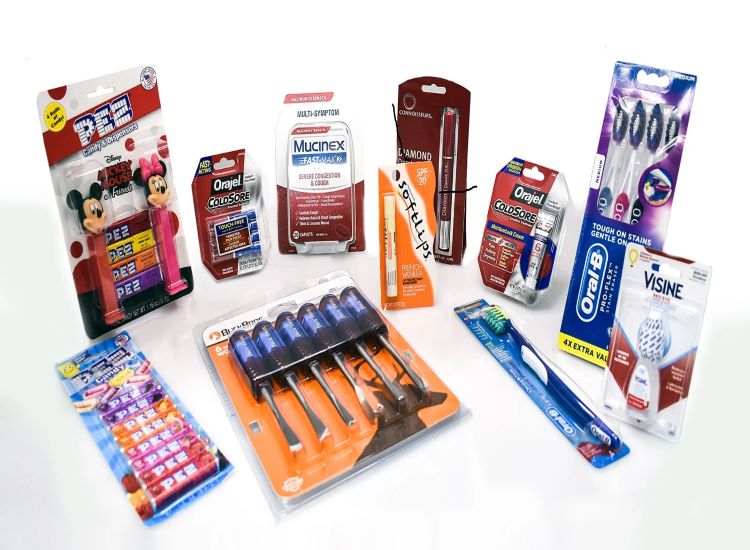Blister packaging, or blister packs, are pre-formed packaging materials with a thermoformed plastic cavity and a pliable lid. A thermo forming process is used to create a cavity or pocket made from a formable transparent plastic web, the size and shape of which is determined by the product for which it is required. This cavity or pocket is typically heat sealed onto an adhesive coated cardboard or foil to trap the contents in place underneath creating a typical blister pack.
That’s why blisters can be made in any shape, a uniform shape to protect tablets, for example, or an unusual shape to protect a less consistently shaped product, like the football figurines shown in the image below.

Blister packaging is widely used in pharmaceutical products such as pills, tablets, capsules, lozenges, etc. It is also used for packaging consumer goods like foods, electronics, toys, and tools.
Types of blister packaging
The most common types of blister packaging are as follows:
Face seal blister

The plastic blister is molded around the product and heat-sealed to a cardboard backing. This type of blister packaging is inexpensive and so is mainly used for large volumes.
Full-face seal blister

The blister surrounds the entire product as well as the card backing. The plastic is either heat-sealed to the card or slid through additional plastic pieces on each side. This type of blister packaging is used to make the packaging stronger (the corners are harder to bend, for instance) and better-looking.
Full card blister

Like the full-face seal blister, the blister covers the full size of the card. But rather than be heat-sealed to the card, it has flanges that wrap around it. The card is slid, and sometimes stapled, into place.
Trapped blister

A trapped blister is almost the same as a traditional blister pack but the plastic part that sticks to the cardboard has another piece of cardboard in front of it that fits around the shape of the blister. This type of packaging uses a single thermoformed sheet trapped inside die-cut cardboard. No sealing tools are required for this.
Types of films used in blister packaging:
PVC or polyvinyl chloride is the most common blister packaging material. The main advantage of using PVC is the low cost. PVC sheets of 0.25 to 0.3mm are used for making blister packs.
PVDC or polyvinylidene chloride is used along with PVC sheets to improve the barrier properties of the packaging. This provides excellent protection from oxygen and moisture.
PCTFE Polychlorotrifluoroethylene is another form of laminate for blister packaging. It is primarily used as a moisture barrier. Compared to all the polymers, PCFTE comes with the minimum value of water vapour permeation.
COP or Cyclic olefin polymers as well as Cyclic olefin copolymers improve the thermoforming in blister packs and even provide good barrier properties. COP, when used with other polymers such as polypropylene and polyethylene, allows manufacturers to make blister packs with deep pockets. These are essential for packing medicines.
Benefits of Blister Packaging
Individual Packaging

Individual packaging helps maintain the quality of the contents through containment in separate cavities or pockets.
Damage to any part of the packaging material will not affect the whole.
Maintaining Product Integrity
Forming films and lidding structures are created according to the sensitivity of the product to moisture, oxygen, and light. The packaging components can be laminated with barriers that block the penetration of external elements.
Opaque materials such as aluminum block light, preventing product degradation through UV radiation.
Tamper Protection

When opened, Blister packs cannot be returned to their original form. Blister packaging has an inherent tamper-evident mechanism since it is impossible to separate the lidding from the blister card without causing visible damage.
This helps deter package pilferage not only in pharmaceuticals but also in consumer goods such as electronics.
Preventing Accidental Drug Misuse

Blisters and lidding structures can be designed so that they cannot be opened easily without following instructions specified by a manufacturer.
This prevents children, and even seniors, from accidentally taking the drug. This design is known as child-resistant (CR) packaging.
Visibility of Product

Blister packaging is also used for retail products since they allow consumers to see the product through the packaging.
Minimal Movement Within Packaging
It is easy for blister packs to take the shape of the product. The products’ shape can be fed through a computer-aided machining program that controls a milling machine for creating mold. The mold can be prepared to factor in only small clearances between the product and the packaging.
Blister packaging is an innovative packaging solution that offers an optimal solution and its importance will only increase as companies rely more on packaging and labelling to protect and promote their products, increase patient compliance, expand their markets and build brand credibility.
Machine Dalal platform is preferred by the buyers and sellers from the global print industry to get directly connected with each other and trade their machinery.
Visit the Machine Dalal website or simply download our app onto your Android or iOS smartphone.




